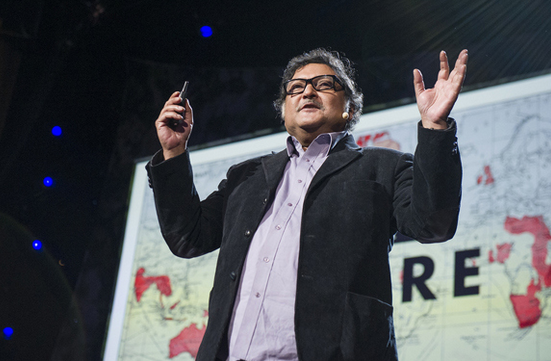I had an opportunity to meet TED 2013 Prize Winner Sugata Mitra who not only spoke on the main TED stage when receiving and acknowledging his prize, but then trekked to Palm Springs from Long Beach to address an eager TedActive crowd who were full of questions about his mission to change how we think about education and educatING.
Known for his work in education research, Sugata Mitra won $1 million TED Prize to build his School in the Cloud.
Many who keeps tabs on education will know him for his project called “Hole in the Wall”, an experiment he conducted in 1999, where Mitra and his colleagues dug a hole in a wall near an urban slum in New Delhi, installed an Internet-connected PC and walked away.
Over time, while a hidden camera filmed the area, the video showed children from the slum playing around with the computer and in the process, teaching themselves now only how to use it themselves, but sharing that knowledge with their friends.
His goal is lofty – he invited the world to embrace child-driven learning by setting up something he refers to as Self-Organized Learning Environments (SOLEs).
He asked for help designing a learning lab in India, where children can “embark on intellectual adventures.”
He said in a chat with a dozen or so of us, he said, “if children are not engaged or motivated in the learning process, you have to ask yourself what are you doing to make them disengaged, not what’s wrong with them?”
Sugata added, “to motivate them to do something, whenever you’re trying something with them, tell the children that they’re trying something new and say I don’t think anyone in the world knows the answer.” He laughed as he pondered this share, clear that he has tried this with success dozens of times.
Aside from advice, he and attendees spoke about the importance of asking a lot of smart questions. For example, how tall is the Eiffel Tower is a bad question since it doesn’t provoke learning or imagination – it’s simple to look that up on Google or elsewhere. Asking, “why would someone be inspired to build something so tall in that exact location in Paris at that time in history” is a much better question since it involves deep exploration, research and thinking.
First photo credit: TED Blog, second one I shot on the lawn at La Quinta Resort, third shot is from TED Blog.

Renee Blodgett is the founder of We Blog the World. The site combines the magic of an online culture and travel magazine with a global blog network and has contributors from every continent in the world. Having lived in 10 countries and explored nearly 80, she is an avid traveler, and a lover, observer and participant in cultural diversity.
She is also the CEO and founder of Magic Sauce Media, a new media services consultancy focused on viral marketing, social media, branding, events and PR. For over 20 years, she has helped companies from 12 countries get traction in the market. Known for her global and organic approach to product and corporate launches, Renee practices what she pitches and as an active user of social media, she helps clients navigate digital waters from around the world. Renee has been blogging for over 16 years and regularly writes on her personal blog Down the Avenue, Huffington Post, BlogHer, We Blog the World and other sites. She was ranked #12 Social Media Influencer by Forbes Magazine and is listed as a new media influencer and game changer on various sites and books on the new media revolution. In 2013, she was listed as the 6th most influential woman in social media by Forbes Magazine on a Top 20 List.
Her passion for art, storytelling and photography led to the launch of Magic Sauce Photography, which is a visual extension of her writing, the result of which has led to producing six photo books: Galapagos Islands, London, South Africa, Rome, Urbanization and Ecuador.
Renee is also the co-founder of Traveling Geeks, an initiative that brings entrepreneurs, thought leaders, bloggers, creators, curators and influencers to other countries to share and learn from peers, governments, corporations, and the general public in order to educate, share, evaluate, and promote innovative technologies.











